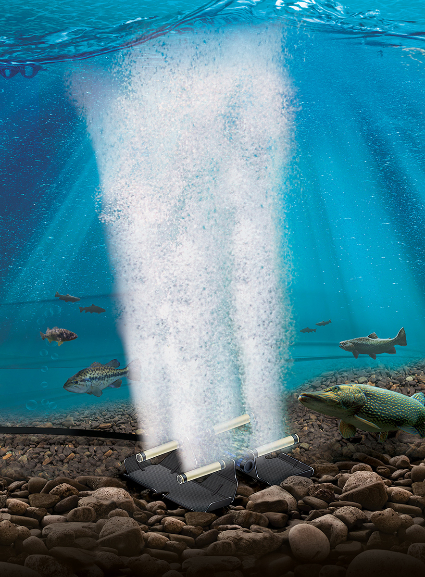
While an aeration system’s specs might make it appear that it could work for a certain pond, the depth, size and shape all must be considered when determining the best aeration system. Once the aeration system has been selected and installed, there are additional factors that will play a role in the overall ongoing success of the aeration system and the beneficial effects it will have on the pond.
How to Determine Pond Size
Taking accurate measurements, including depth, on site is the best method to determine a pond’s size. Traveling to a pond to take measurements, however, is not always a viable solution when determining the size of the pond and what aeration system is best.
Using aerial mapping programs can offer a nice overhead view of the pond. Accurate measurements can then be taken, allowing you to account for seasonal and yearly variations in the overall size of the pond. While there are many products and websites available that offer an array of overhead views, some may not always offer an accurate representation of the current pond. Many states and counties offer access to online maps that may provide newer images not readily available on other services.
If all else fails, or if the pond is newer and not shown on a mapping service, asking the customer to draw out the pond as accurately as possible can often provide enough information to properly size an aeration system.
Depth & Shape Considerations

Depth is vital when determining which aeration system will work best in any pond. Bottom diffused aeration relies on rising air bubbles to lift water from the bottom of the pond to the surface. The amount of water lifted to the surface and the overall turnover rate created by the aeration system are directly affected by the depth of the diffusers.
Diffusers placed deeper in the pond will affect a larger area. Given two ponds with similar surface areas, the deeper pond will oftentimes require fewer diffuser plates, because each diffuser will have a larger zone of influence. Variations in depth must also be accounted for when sizing an aeration system. A diffuser placed at or near the maximum pond depth will affect a much larger area of the pond than a diffuser placed at a shallower depth or one placed closer to the shoreline.
Pond shape is also vital when selecting the proper aeration system for a pond. While surface area and depth will help you determine the minimum-size aeration system that may be necessary, the shape of the pond will influence the overall movement of the water, which may create the necessity for additional diffuser plates.
Islands, coves, peninsulas and inlets will all limit the overall zone of influence of each individual diffuser plate. Additional diffuser plates may be needed to properly move the water in these areas. Failure to account for the shape of the pond can result in areas with little to no water movement, leading to areas with stagnant water, an accumulation of nutrients and accelerated algae growth. Long, narrow ponds will also require additional diffuser plates over similarly sized round ponds. The shape of these ponds limits the influence of each individual diffuser plate, so additional plates will be necessary in long, narrow ponds to ensure the entire waterbody is being circulated properly.
Installation of Bottom Diffused Aeration

There are many additional steps that can be taken both during and after installation to enhance the success of the aeration system and add to the lifespan of the components of the system. During installation, it is recommended to cut down on excess airline after the diffuser plates have been installed in their proper positions. Excess airline will increase the operating pressure of the system, which can lead to premature wear on the compressor.
Once an aeration system is installed, it should not be allowed to run nonstop at first. Always recommend a slow start-up, with the system only running 30 minutes the first day. Run time should then be doubled each day, increasing the run time until it is running 24 hours a day by the end of the first week.
Harrison Hugo, Airmax
Once an aeration system is installed, it should not be allowed to run nonstop at first. Always recommend a slow start-up, with the system only running 30 minutes the first day. Run time should then be doubled each day, increasing the run time until it is running 24 hours a day by the end of the first week. A slow start-up prevents a sudden turnover event. A sudden turnover event will drop the dissolved oxygen level of the pond and can lead to a fish kill. Taking the time to do a gradual start-up of the aeration system will drastically decrease the chances of a fish kill occurring.
Aeration System Maintenance
After the aeration system is up and running, air filters should be checked monthly. Clogged air filters will restrict air flow and can lead to overheating and premature wear on the compressor. Air filters should be changed regularly for optimal performance. Additionally, maintenance should be completed on the compressor every 12 to 18 months, depending on the type of compressor and the operating pressure. Internal parts will wear down over time due to heat and friction. Changing out these internal parts will prevent damage to the compressor. Failure to do so can lead to catastrophic failure and require a replacement compressor to be installed.
A properly sized aeration system is a great step toward achieving a healthy pond. Accounting for the pond size, depth and shape will ensure that the best aeration system is selected for each pond, yielding the best results. Proper installation, start-up and maintenance will ensure that the system continues running properly, keeping the pond healthy and enjoyable for years to come.



Great article! Well written and informative.